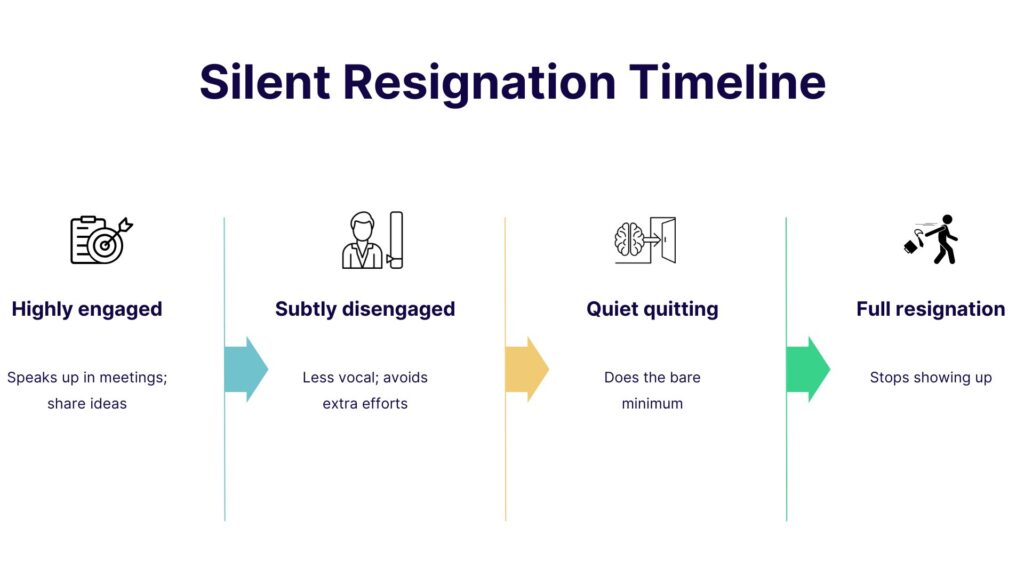You can feel it long before you see it on a report. A sharp employee who used to lead brainstorming sessions now just nods quietly. Another who always turned in ideas before deadlines suddenly only does what’s asked, nothing more. There’s no goodbye party. No dramatic handover. Just a quiet retreat. They’re still on the payroll, but they’ve mentally checked out.
Welcome to the silent resignation.
It’s not a new phenomenon. But it’s gotten a lot harder to ignore. Call it quiet quitting, disengagement, or plain burnout, this isn’t about laziness. It’s about a quiet unraveling. A dimming of drive, of belonging, of purpose at work. And when that spreads, even top-tier cultures start to feel hollow.
So what’s going on here? And more usefully, how do you turn it around?
Not quite quitting, but not quite caring either
This isn’t your traditional turnover story. People aren’t storming out or submitting dramatic resignation letters. They’re staying. But mentally, emotionally, sometimes even creatively, they’ve left the building.

Gallup’s 2023 State of the Global Workplace report found that nearly six in ten employees are not engaged at work. These aren’t slackers or bad hires. Often, they were your A-players, until something shifted. And that shift? It’s rarely about pay.
Let me explain.
The real reasons people disengage (that have nothing to do with perks)
We love to talk about beanbags, bonuses, and flexible Fridays. But the truth is, most people check out for deeper reasons:
- They don’t feel seen. Recognition is rare. Feedback is vague. They’re just another cog in the machine.
- They don’t trust leadership. Promises are made, but what people experience day to day doesn’t match.
- They don’t see a future. Growth paths are unclear. Promotions feel political.
- They’re burned out. Not just tired, emotionally drained, stuck in reactive loops with no recovery.
- They feel isolated. Remote work helped many but also created silos and loneliness.
- They feel disconnected from their strengths. When work constantly asks them to be someone they’re not, it drains them. They want to do work that feels natural, energising, not like they’re swimming against the current every day.
And sometimes, it’s not even one big thing. It’s the slow erosion of meaning. When every day starts to feel the same and their work feels disconnected from who they are, people slowly let go.
So… how do you fix it?
There’s no single solution. But here are a few things that actually help:
1. Bring back meaning, not just motivation
People want to feel like their work matters. That it connects to something bigger than just hitting targets or closing tickets. Meaning doesn’t have to come from grand missions; it can come from clear purpose, team connection, or even just understanding how their work fits into the bigger picture.
What helps:
- Connect roles to real impact.
- Share stories of how someone’s work changed something for a customer or colleague.
- Make sure leaders explain purpose, not just deliverables.
2. Let people lead with their strengths
When people get to use the things they’re naturally good at, it doesn’t just feel better, it works better.
Whether it’s a team member who thrives on solving messy problems, or someone who brings energy through relationship-building, strengths aren’t just nice-to-know qualities. They’re clues to how people work best.
And when leaders know and lean into those strengths, they’re not just managing, they’re helping people come alive at work.
Strengths-based teams tend to see better collaboration, more creativity, and fewer disengaged employees. It’s not a magic trick. It’s just human nature: when we feel seen for who we really are, we show up differently.
3. Fix the feedback loop
People crave feedback, but not the robotic kind. Not just performance reviews and pulse surveys. They want real, specific, actionable input. Feedback that feels personal, not procedural.
Managers need to ask better questions. And just as crucially, they need to truly hear what’s being said.
4. Build psychological safety (for real)
If people are afraid to speak up, they’ll eventually stop trying. Psychological safety isn’t about being soft, it’s about creating space for honesty without fear of punishment.
Want people to bring their ideas, concerns and creativity? Make it safe to be human.
The cost of doing nothing? Higher than you think

Silent resignation doesn’t show up on a balance sheet, but it eats away at productivity, innovation, and morale. It leads to quiet conflict, missed opportunities, and a culture of “just enough.”
You might not see it in the metrics until it’s too late.
And replacing these employees later? It’ll cost you far more than keeping them engaged today.
Final thoughts: They’re still showing up. That’s your window.
If someone’s still here, still logging in, still clocking in, it means there’s still hope. Silent resignation isn’t the end. It’s a signal.
A signal that says: “I’m not done. But I need something to change.”
Maybe it’s better support. Maybe it’s clarity. Maybe it’s a chance to lead with their strengths.
Whatever it is, your next move could make the difference between someone quietly leaving or finally coming back to life at work.
The choice is still yours.





